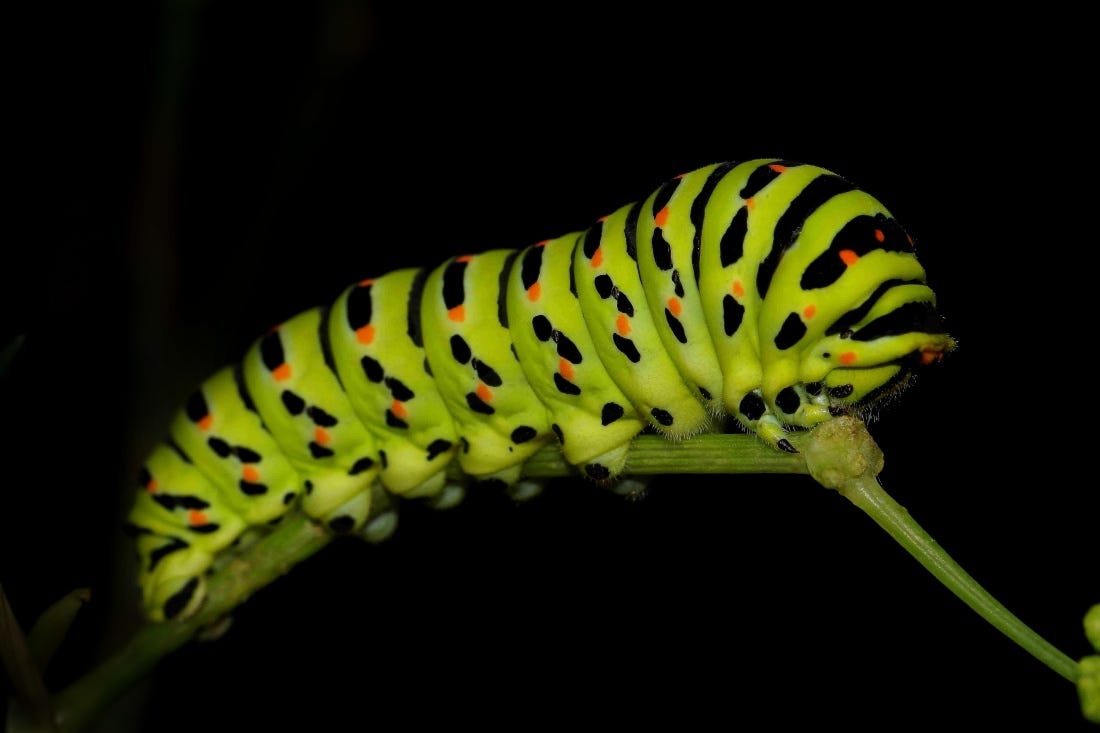Caterpillar
Caterpillar Facts
Kingdom: Animalia
Phylum: Arthropoda
Class: Insecta
Order: Lepidoptera
Common Name: Caterpillar
Scientific Name: Larva
Location: Worldwide
Diet: Herbivore
Size: 30-60mm (1-2in)
Number Of Species: 21,000
Average Lifespan: 3 weeks
Conservation Status: Least Concern
Colour: Yellow, Black, Orange, Red, Green, Blue, White. Brown
Skin Type: Hair
Favourite Food: Leaves
Habitat: Quiet forests and pastures
Average Litter Size: 0
Main Prey: Leaves, Plants, Flowers
Predators: Birds, Wasps, Mammals
Special Features: Long body shape and fleshy horns
The caterpillar is the larvae (the baby) of both a butterfly and a moth. After around 2-3 weeks, the caterpillar builds itself into a cocoon where it remains a pupa for a further 2 weeks. The caterpillar then emerges having grown wings.
The moth caterpillar is well known for being a pest, particularly in the fabric industry. One species of caterpillar has destroyed reams of silk in the far east, known in China as a silkworm.
Generally, most species of caterpillar are considered to be agricultural pests as they can munch their ways through fields of crops, often leaving enormous holes which result in unhealthy or inedible plants.
Some species of caterpillar are also highly poisonous, particularly those species that live in the tropical rain forests. Other species are only poisonous in their caterpillar form, meaning when they turn into a moth or butterfly, they no longer have venom.
There are more than 20,000 different species of known caterpillar found all around the world and it is estimated that there are many more that are undiscovered as new species of butterflies and moths are regularly found in regions where there is little, if any, human presence.
Caterpillars difference in size, colour and appearance depending on their species. Some caterpillars are very brightly coloured where other caterpillar species are quite dull-looking in comparison. Some species of caterpillars are very hairy, where others are very smooth. The main aim of the appearance of the caterpillar is to intimidate its predators and to deter them from eating it.
The caterpillar, like the butterfly, is a herbivorous animal but the diets of the caterpillar and the butterfly are very different. Butterflies use their long straw-like tongues to drink the nectar out of flowers, which is an adaptation that occurs in the process where the caterpillar becomes a butterfly. Caterpillars mainly feed on leaves, plants and flowering plants and big holes can often be found in leaves indicating the presence of a caterpillar.
A number of species of caterpillar are known to be carnivorous and eat a variety of insects that pass them. One caterpillar species found in Hawaii, hooks itself onto a leaf where it stands very straight trying to catching passing bugs.
Due to their small size and worm-like shape, caterpillars are preyed upon by numerous different species of animal but the main predators of the caterpillar are birds and large insects such as wasps. Caterpillars are also commonly preyed upon by small mammals and reptiles.


Kingdom: Animalia
Phylum: Arthropoda
Class: Insecta
Order: Lepidoptera
Common Name: Caterpillar
Scientific Name: Larva
Location: Worldwide
Diet: Herbivore
Size: 30-60mm (1-2in)
Number Of Species: 21,000
Average Lifespan: 3 weeks
Conservation Status: Least Concern
Colour: Yellow, Black, Orange, Red, Green, Blue, White. Brown
Skin Type: Hair
Favourite Food: Leaves
Habitat: Quiet forests and pastures
Average Litter Size: 0
Main Prey: Leaves, Plants, Flowers
Predators: Birds, Wasps, Mammals
Special Features: Long body shape and fleshy horns
The caterpillar is the larvae (the baby) of both a butterfly and a moth. After around 2-3 weeks, the caterpillar builds itself into a cocoon where it remains a pupa for a further 2 weeks. The caterpillar then emerges having grown wings.
The moth caterpillar is well known for being a pest, particularly in the fabric industry. One species of caterpillar has destroyed reams of silk in the far east, known in China as a silkworm.
Generally, most species of caterpillar are considered to be agricultural pests as they can munch their ways through fields of crops, often leaving enormous holes which result in unhealthy or inedible plants.
Some species of caterpillar are also highly poisonous, particularly those species that live in the tropical rain forests. Other species are only poisonous in their caterpillar form, meaning when they turn into a moth or butterfly, they no longer have venom.
There are more than 20,000 different species of known caterpillar found all around the world and it is estimated that there are many more that are undiscovered as new species of butterflies and moths are regularly found in regions where there is little, if any, human presence.
Caterpillars difference in size, colour and appearance depending on their species. Some caterpillars are very brightly coloured where other caterpillar species are quite dull-looking in comparison. Some species of caterpillars are very hairy, where others are very smooth. The main aim of the appearance of the caterpillar is to intimidate its predators and to deter them from eating it.
The caterpillar, like the butterfly, is a herbivorous animal but the diets of the caterpillar and the butterfly are very different. Butterflies use their long straw-like tongues to drink the nectar out of flowers, which is an adaptation that occurs in the process where the caterpillar becomes a butterfly. Caterpillars mainly feed on leaves, plants and flowering plants and big holes can often be found in leaves indicating the presence of a caterpillar.
A number of species of caterpillar are known to be carnivorous and eat a variety of insects that pass them. One caterpillar species found in Hawaii, hooks itself onto a leaf where it stands very straight trying to catching passing bugs.
Due to their small size and worm-like shape, caterpillars are preyed upon by numerous different species of animal but the main predators of the caterpillar are birds and large insects such as wasps. Caterpillars are also commonly preyed upon by small mammals and reptiles.


Comments
Post a Comment